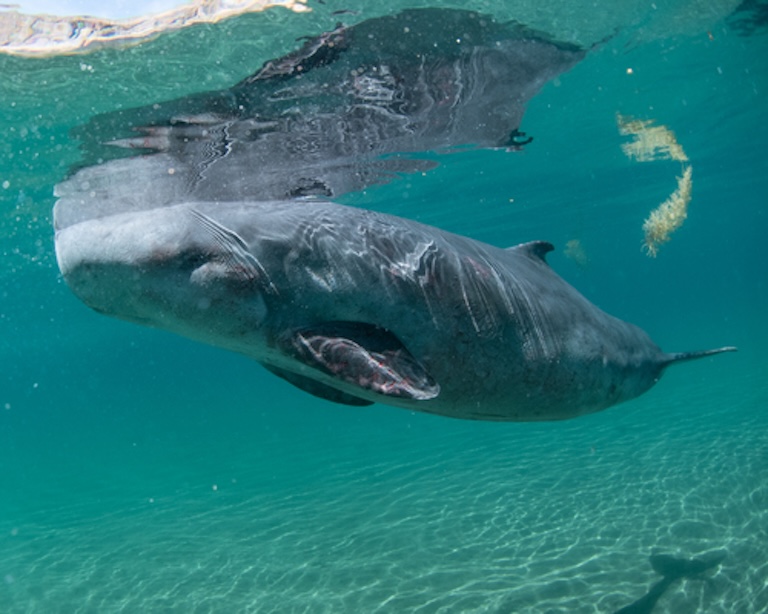Pygmy Sperm Whale Profile
The sperm whale is probably the best animal on the planet. This prehistoric giant has the largest brain in the animal kingdom and communicates across vast distances using intricate vocal language and a boom that can break a limb.
Unfortunately, much of its grandeur wasn’t passed down to its smaller cousins, and the pygmy sperm whale – at least, from what little we can gather about it – is a sort of runty, base model with none of the expensive optional extras.

Pygmy Sperm Whale Facts Overview
| Habitat: | Marine |
| Location: | Warm, deep waters worldwide |
| Lifespan: | 23 years |
| Size: | Up to 3.5 m (11 ft) |
| Weight: | Around 400 kg (880 lb) |
| Colour: | Bluish grey with a creamy or pinkish belly |
| Diet: | Cephalopods |
| Predators: | Large sharks, orcas |
| Top Speed: | Relatively slow |
| No. of Species: | 1 |
| Conservation Status: | Least Concern (IUCN) |
Pygmy sperm whales are strange little dudes. They’re the smallest of the sperm whale group, and unlike their giant (and somewhat distant) cousins, they have one less stomach and can spray ink like a fish.
They have simpler brains, too, but that’s about where our knowledge of these whales ends – they are highly elusive and timid animals, and most of what we know comes from investigating their corpses after strandings. Which, sadly, they do a lot.
Interesting Pygmy Sperm Whale Facts
1. They’re small-ish
Pygmy sperm whales aren’t all that closely related to their namesakes, the largest-toothed whales. They’re a different family entirely: the Kogiidae, which is rather empty except for these guys and one other species, the similarly diminutive Dwarf sperm whales.
Both these half-pint cetaceans share the superfamily Physeteroidea, which they do share with true sperm whales, making them closer to sperm whales than anything else. And size is relative – these miniature whales still weigh up to 400 kg.
But pygmy sperm whales are smaller even than dwarf sperm whales, and much closer in size to dolphins.

2. They’re short faces
Unlike dolphins, pygmy sperm whales have very short noses. Along with the dwarf sperm whales, they have the shortest rostrum of any cetaceans and a weird-shaped head that isn’t symmetrical.
Their flippers are also much closer to their heads than is usual and their dorsal fins are way down their backs, similar to the ridge found on a true sperm whale.
But compared with the sperm whales, they have a reduced gut.
3. They have three stomachs
This might sound like a lot until you realise that sperm whales have four!
Pygmy sperm whales don’t have enough room for that many chambers, but they do have a commendable three-chambered stomach which work together to process their special diet. Like ruminants, the digestion of sperm whales follows a system of chambers.
The first is the forestomach, and this is usually where all the cephalopod beaks are found. Being suction feeders, these whales need an armoured chamber to store their struggling food before passing it into the delicate digestive areas of the gut.
The forestomach is thickened and muscular, and likely where many poor squid spend their final moments.
This passes into the second stomach which is lined with digestive glands, and leads through to a third chamber with yet more digestive juices in it. Finally, a sphincter separates this from the duodenum.
4. They’re a bit runty
Compared with the sperm whales, who own the largest brains in the animal kingdom, pygmy sperm whales are relatively simple-brained animals. They have fewer neurons, proportionally, and are less social overall.
However, these brains do contain a whole bunch of magnetite crystals, which are not only critical to building fabricators in Subnautica but also great at picking up magnetic fields if you’re a pygmy sperm whale.
This is a useful adaptation, considering these whales spend so much time in the dim light of the deep ocean. 1
5. They have a monkey’s muzzle
In whales that use a melon-based communication system, there’s an organ similar in function to the vocal cords of a human. A pair of fleshy lips slap together to generate the initial sound, and this is the organ known as the monkey’s muzzle in whales.
In sperm whales, this organ has one pair of membranes, but in the pygmy sperm whales, there are two.
They’re located on the nasal passage, and using a sort of snoring mechanism, they’re slapped together with the passing of air, and the sound that’s produced is passed through the melon, which acts like the lens of a human eye, concentrating and directing the sound to the target.
This system is used for talking and for echolocation, as a way of seeing in the dark using reflected sound.
6. They release ink
In a strange twist, these squid-eating whales share a trait with their prey. At the back end of each whale is an internal sack that contains a dark, ink-like fluid.
Along with the dwarf sperm whales, these are the only whales known to use this defensive strategy, which involves the release of up to 12 litres of the stuff from the anal opening.
The resulting cloud obscures the whale’s escape from predators, which, being small, they have a lot of. And, being small, they’ve perfected avoidance as a strategy to stay safe.
7. They’re super rare
Pygmy sperm whales are very skittish animals and will flee from planes and boats, and other noisy things researchers commonly use to study wild animals.
But on top of this, they spend very little time near the surface of the ocean at all, making them very hard to figure out. While they’re found in temperate and tropical waters all over the world, they aren’t well understood, and from a distance, they’re almost impossible to tell apart from the dwarf sperm whales.
Most of what we know comes from their bodies, as they’re washed up on the beach. 2
8. But they stranded a lot
Sadly, this happens quite a lot, and alongside hunting and bycatch, strandings are a legitimate threat to the species.
Ocean noise is emerging as a leading cause of death among cetaceans who navigate with sound, and this comes not only from the blinding effect on their navigation but also from conditions like the bends, in which whales get spooked or hurt by super loud sonar and rush to the surface to escape it, resulting in decompression sickness, which can then result in strandings.
So far, this species is listed as of Least Concern to the IUCN, but the trends are unknown, and with an animal this hard to study, this ranking is unlikely to be one of high confidence. 3
Pygmy Sperm Whale Fact-File Summary
Scientific Classification
| Kingdom: | Animalia |
| Phylum: | Chordata |
| Class: | Mammalia |
| Order: | Artiodactyla |
| Family: | Kogiidae |
| Genus: | Kogia |
| Species: | breviceps |
Fact Sources & References
- “Pygmy Sperm Whale”, NOAA Fisheries.
- “Pygmy sperm whale”, WDC.
- “Pygmy Sperm Whale”, IUCN Red List.
